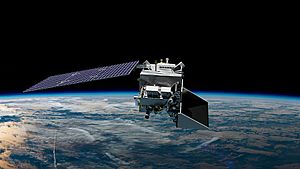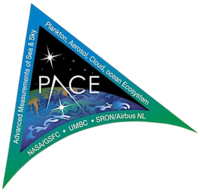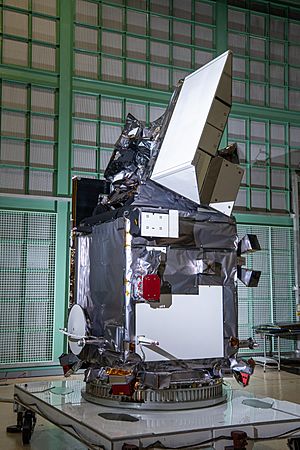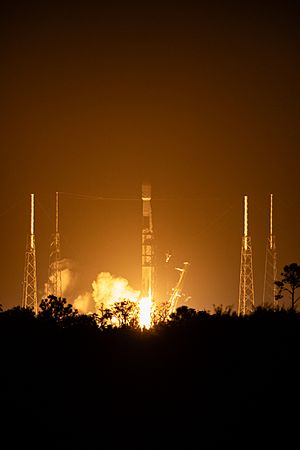Plankton, Aerosol, Cloud, ocean Ecosystem facts for kids

An artist's concept of NASA's PACE spacecraft in orbit.
|
|
| Names | Pre-Aerosol, Cloud, and ocean Ecosystem PACE |
|---|---|
| Mission type | Remote sensing |
| Operator | NASA |
| Mission duration | 3-10 years (planned) 1 year, 11 months, 3 days (in progress) |
| Spacecraft properties | |
| Spacecraft | PACE |
| Manufacturer | Goddard Space Flight Center |
| Launch mass | 1694 kg |
| Dimensions | 1.5 x 1.5 x 3.2 meters |
| Power | 1000 watts |
| Start of mission | |
| Launch date | 8 February 2024, 06:33 UTC |
| Rocket | Falcon 9 Block 5 |
| Launch site | Cape Canaveral, SLC-40 |
| Contractor | SpaceX |
| Orbital parameters | |
| Reference system | Geocentric orbit (planned) |
| Regime | Sun-synchronous orbit |
| Altitude | 676.5 km |
| Inclination | 98.0° |
| Period | 2-day global coverage 60° instrument view angle |
 PACE mission logo |
|
The Plankton, Aerosol, Cloud, ocean Ecosystem (PACE) is a special NASA satellite. It orbits Earth to study our planet's oceans, tiny particles in the air (aerosols), and clouds. This mission helps scientists learn more about the carbon cycle and how our environment changes.
PACE will help us find out how big and how long phytoplankton blooms last. It will also help us understand air quality better. The information from PACE will be useful for many things, like keeping our water quality good, helping fisheries, and making sure we have enough food security.
The PACE project is managed by NASA's Goddard Space Flight Center. The main parts of the satellite were designed and built there. On February 8, 2024, PACE successfully launched into space.
Contents
PACE Mission: A Look Back
The PACE mission was first called Pre-Aerosol, Cloud, and ocean Ecosystem. It was approved to move forward with its planning on June 16, 2016. This meant the project could start using its official budget from July 1, 2016.
Why PACE Matters: Science Goals
PACE has two main science goals. First, it aims to continue collecting important data about ocean color, aerosols, and clouds. This helps us understand Earth's climate over time. Second, it will use advanced instruments to answer new science questions. These instruments are much better than those on older missions.
The ocean and atmosphere are closely connected. They constantly move and share energy, water, nutrients, gases, and even pollution. Tiny particles like aerosols, clouds, and phytoplankton can also affect each other.
PACE will measure particles and clouds in the atmosphere that interact with sunlight. By studying aerosols better, scientists can figure out how they impact marine biology and ocean chemistry. They can also see how aerosols affect Earth's energy and help predict changes in nature.
PACE will help scientists keep a closer eye on fisheries. It can also spot harmful algal blooms and observe changes in ocean resources. The color of the ocean changes based on what's in the water, like chlorophyll. Chlorophyll is a green color found in most phytoplankton. By watching where phytoplankton are and how many there are, the mission helps us understand how ocean life works.
PACE's Scientific Tools
Oceans are very important for life on Earth and for the global economy. To understand how ocean health changes with climate, scientists started planning for an advanced ocean biology satellite mission in 2000. This plan was part of a bigger NASA effort to study the carbon cycle in oceans, land, and the atmosphere.
Here are the main instruments on the PACE satellite:
- Ocean Color Instrument (OCI): This is the main sensor. It's a very advanced tool that measures light. It can measure the ocean's color from ultraviolet light to shortwave infrared light. This helps scientists get very detailed information about the ocean's color.
- Spectro-Polarimeter for Planetary Exploration (SPEXone): This instrument looks at sunlight reflected from Earth's atmosphere, land, and ocean. It measures how light is polarized, which helps scientists study aerosols (tiny particles in the air). Aerosols can affect climate by interacting with sunlight and by changing clouds. SPEXone will provide very accurate measurements of these particles.
- Hyper-Angular Rainbow Polarimeter #2 (HARP2): This tool is designed to measure aerosol particles and clouds. It also looks at properties of land and water surfaces. HARP2 collects data from many different viewing angles and light colors. This helps scientists understand the size, amount, and shape of atmospheric particles. HARP2 was built by the University of Maryland, Baltimore County (UMBC). An earlier version, HARP, was launched to the International Space Station in 2019.
PACE Mission: Launch and Orbit
Launching PACE into Space
PACE launched on February 8, 2024, at 1:33 AM EST. It was carried by a SpaceX Falcon 9 rocket from Cape Canaveral Space Launch Complex 40. The launch was delayed for two days because of bad weather.
Soon after launch, the rocket made a special turn to fly south. After the first part of the rocket separated, it flew back to the launch site. This part of the rocket can be used again for future flights. This was the fourth flight for this specific rocket booster. The second part of the rocket pushed PACE into its final orbit, about 676.5 kilometers high. The satellite separated from the rocket about 13 minutes after launch.
This launch was unusual because it went into a polar orbit from Florida. Usually, rockets going into polar orbits launch from California. This is to make sure any falling rocket pieces land safely in the ocean. However, SpaceX can land its Falcon 9 booster safely. Also, they use a special system called the Autonomous Flight Safety System. This allows them to launch polar missions from Florida. PACE was the first U.S. government mission to launch into a polar orbit from Florida since 1960. Launching from Florida was convenient because it's closer to the Goddard Space Flight Center, where the mission is managed.
The launch cost about $80.4 million. After the launch, the mission entered a 60-day period to get everything ready. After that, the science data from PACE will start to be shared with scientists.
See also
- NASA Earth Science
- Earth Observing System
- List of NASA Large Strategic Science Missions



